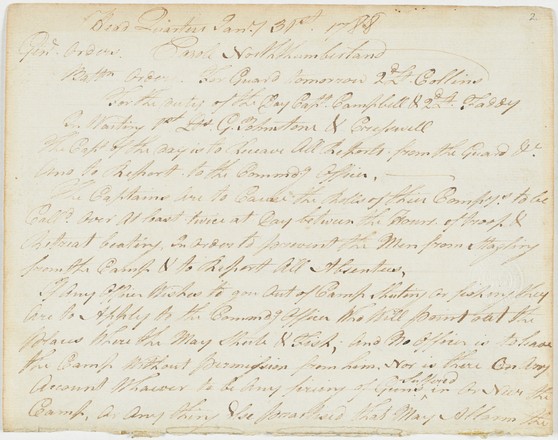Orderly book of Captain James Campbell
30 January – 3 February 1788
Manuscript
Bequest of Sir William Dixson, 1952
DLMS 33
If any officer wishes to go out of Camp Shooting or fishing they are to apply to the Commanding officer who will point out the places where [they] may shoot & fish; and no officer is to leave the camp without permissions from him … *
Especially in the early days of the colony, permission was essential for every activity, no matter how small. Orderly books such as this record the general and regimental orders that enabled the settlement to become established and kept it in some order during these critical first weeks and months.
This orderly book was kept by captain of the Marines James Campbell. Arriving with the First Fleet, he went on to supervise the establishment of the settlement at Rose Hill (Parramatta) and took a great interest in the local plants and animals, sending natural history specimens, including a kangaroo skin, back to his patron and Royal Navy captain, Lord Ducie. At the same time, he was relentlessly critical of Phillip's governorship. Believing that the settlement could not succeed, he quickly became one of the most disgruntled of the officers. He returned to England on the Gorgon, departing December 1791.
First Fleet
The First Fleet, consisting of 11 vessels, was the largest single contingent of ships to sail into the Pacific Ocean. Its purpose was to establish a convict settlement on the east coast of Australia, at Botany Bay. The Fleet consisted of two naval escorts, HMS Supply and the flagship HMS Sirius, carrying the governor; six convict transports, the Alexander, Charlotte, Friendship, Lady Penrhyn, Prince of Wales and Scarborough; and three storeships, the Borrowdale, Fishburn and Golden Grove.
The Fleet sailed from England on 13 May 1787, carrying more than 1500 people, and arrived at Botany Bay eight months later, on 18 January 1788. Sir Joseph Banks had given Botany Bay a glowing recommendation as a site for a future settlement, but Phillip instead chose Port Jackson, to the north. According to Phillip, Port Jackson had everything the new arrivals needed: deep water close to shore, shelter and fresh water. Phillip named the new site Sydney Cove, after Lord Sydney, the British home secretary.
The State Library’s First Fleet collection includes journals, letters, drawings, maps and charts created by those who actually travelled with the First Fleet. These powerful eyewitness accounts not only tell us about how the British viewed Port Jackson and its inhabitants, they also record the hopes and ambitions of the First Fleeters, their feelings of homesickness and despair, along with detailed descriptions of the unfamiliar natural environment.
A new genus of bird
The First Fleet’s surgeon, Arthur Bowes Smyth, also sailed to NSW on board the Lady Penrhyn, and also recorded his experience. Like Campbell, he also took a great interest in natural history, collecting specimens and making drawings, including making the earliest-known illustration by a European of the emu:
"The Animals we saw during our stay at New Holland; (In discribing Botany Bay I take in Port Jackson also, being only 5 miles distant & in most respects the same) I say then, That during our stay there of 3 months, the different Animals we saw, were Kangaroos, abt. as big as a large Sheep a very large Species of Li/ard, Dogs, Rats, Raccoons, flying Squirrels -- very large Snakes -- a Bird of a new genus, as large & high as an Ostrich -- Many species of Cockatoos, Parrotts, Loury & Louryquets, Eagles, Hawks, (Rooks & wild fowl of many sorts vizt. Duck, Teal, Widgeon & ca.) the same as in England; wt. an infinity of small Birds, some of them very handsome plumage but none that we heard of were singing ones –"*
Journal of the First Fleet surgeon Arthur Bowes Smyth, 21 January 1788
Footnotes
* A Journal of a Voyage from Portsmouth to New South Wales and China in the Lady Penrhyn, ML Safe 1/15



 Back to list
Back to list